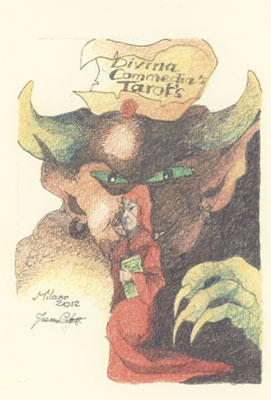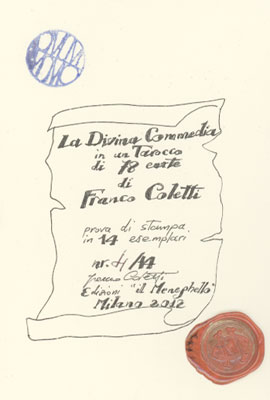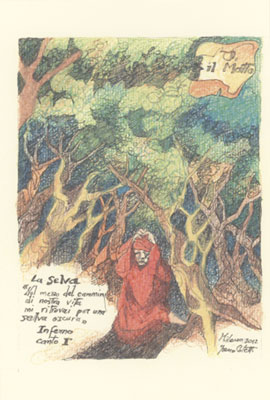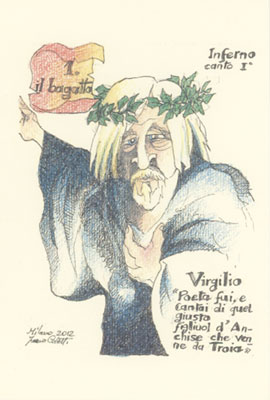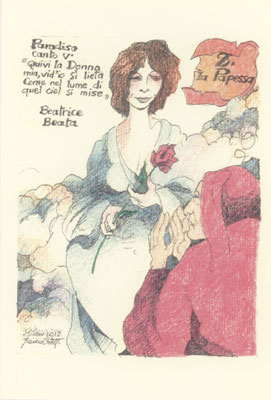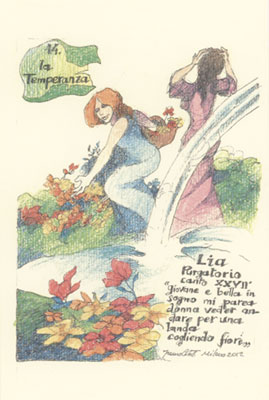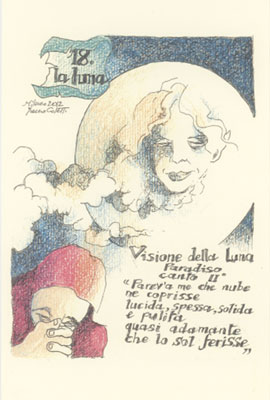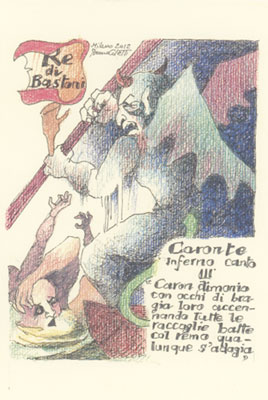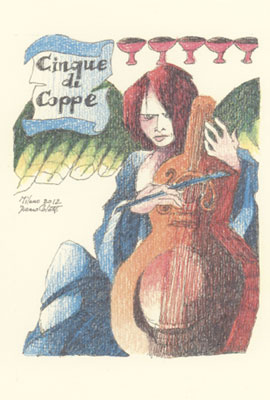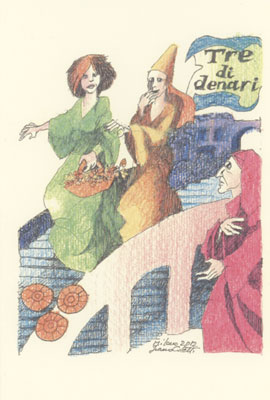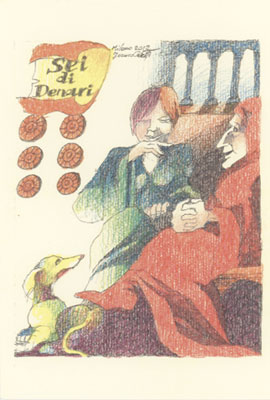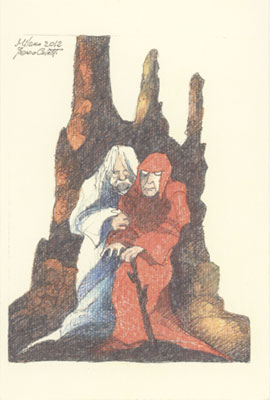Divina Commedia's Tarots - The Divine Comedy’s Tarot
A Very Limited Edition 78 Card Deck Set
Inspired by Dante's Epic Poem, The Divine Comedy
Created by Franco Coletti
Published by il Meneghello in 2012
Only 14 Special Edition Sets Available
Signed & Numbered by Franco Coletti
Text in Italian, with an 18 page booklet in English upon request
Card Dimensions: 5.5 inches by 3.25 inches, approximately (13.97 x 8.26 cm.)
Card Backs: Have an Image (Shown Below) - Not Reversible
Price: € 120. Euro - Sorry, Out of Print
While I was excited to do a review of this extraordinary deck created by Osvaldo's friend Franco Coletti, I won't pretend to
comprehend the complexities of Dante's Epic poem, the Divine Comedy for which this deck is based
upon, but rather will remark on the
presentation, while including some personal insights shared by the artist
regarding his creative process,
(which he kindly translated into English). But for those who are unfamiliar with Dante's Divine Comedy, a little background
info is in
order to give this enormous undertaking of Coletti some added meaning.
The Divine Comedy is an epic poem written by Dante between 1308 and his death in
1321. It is widely considered the most important work of Italian literature and
one of the greatest in world literature. It has been translated into several
languages and has inspired many well known writers such as T. S. Eliot, Samuel
Beckett, C. S. Lewis and James Joyce and countless artists including William
Blake and Salvador Dali. The poem's imaginative and allegorical vision of the
afterlife is a culmination of medieval perspectives as they evolved in
Christianity. It also helped establish the Tuscan dialect, in which it was
written, as the standardized Italian language. Dante referred to the poem as a
'Comedy' (the adjective 'Divine' was added during the 14th century) because
poems of that era were classified as either High ('Tragedy') or Low ('Comedy').
“Low” literature typically had happy endings
and was written in everyday language, whereas “High” poetry addressed more serious matters and was written in an elevated style. Dante
was one of the first during the medieval period to write about such a serious subject as spiritual redemption in the "common" Italian
language and not in Latin, as one would expect (though he did write it in the
the Tuscan dialect which is considered quite melodic and beautiful).
The Divine Comedy is divided into three parts: the Inferno, Purgatory, and Paradise. On one level, this epic poem describes Dante's
journey through Hell, Purgatory, and Heaven, but on a deeper level, it represents allegorically the soul's journey towards salvation
and enlightenment. The poem is written in the first person, and shares Dante's sojourn through the three realms of the dead.
The Roman poet Virgil guides Dante through Hell and Purgatory; while Beatrice, (Dante's vision of the ideal woman), guides him through
Heaven. Beatrice was a Florentine woman whom Dante had known from childhood and had adored from afar.
The structure of the poem is quite complex, with numerological patterns arching
throughout the work. And we can also discover many familiar archetypal themes
that we may recognize as later influencing Tarot’s evolution during the Italian Renaissance
period. The poem is often praised for its powerful and imaginative style and the personal approach and skillful description of the
characters Dante encounters in Hell, Purgatory, and Paradise along with his bitter condemnations of Florentine and Italian politics.
And now back to Franco Coletti's deck that was inspired by this epic medieval
work, with the
goal of transformation through the creative process. Osvaldo Menegazzi is cited in the text as being instrumental as both wise consul
throughout the experience, as well lending practical help in the publishing of
this project. Osvaldo is
portrayed in many of the card images as the character Virgil who guided Dante (and in this case Coletti) through the dark terrain of
both mind and heart. Two of these cards which depict Osvaldo are shared below:
the Magician and the card back (they are depicted walking away from the viewer
in the two of diamonds/coins card it is worth noting). Morena Poltronieri, creator and curator of the Tarot Museum
is also acknowledged in the text as a kind supporter of his work. Coletti lends her face to the Florentine lady in the 6 of diamond's
card, (below) with whom Dante shared a rare moment of peace. But the one who shows up most,
playing the role of muse, tormentor,
guide and object of desire is Coletti's true love 'D', for whom he dedicates this
work as well as several other powerful decks; a few of
which will also be reviewed on this site. 'D' as she is known throughout Coletti's work represents Dante's beloved Beatrice in this
adaptation of the Divine Comedy. She wears many masks including High Priestess (shown below),
and the Empress as well as the Devil, Temperance and Moon (both shown below),
and the
World. She is also portrayed in several of the minor arcana.
To be so consumed and inspired by love must be both a blessing and a curse but we benefit from his personal journey through
hell, purgatory and the heavenly pursuits of love.
My only lament with this gorgeous deck set is that it is available in such a limited edition of only 14 signed
and numbered sets. As lovely and precious as it is to behold, I only hope that
another version of a larger and wider publication will become available for those who may wish to study the dramatic grandeur of this
epic poem in this inspirational manner or who can relate to the spiritual and powerful journey.
The cards are a pale yellow, and made of textured cardstock. A couple of the
images are sexually graphic in nature and a few depict violence but since
they are illustrations, I hope they would not offend anyone but it is worth
noting. The backs have the reverse image of the 2 of coins card (Osvaldo and Coletti
walking towards the viewer) and are therefore
not reversible. The deck includes a title card and a numbered, signed
signature
card. An English version of the enclosed booklet is available upon request and is well worth reading. It shares the
artist's personal exploration as it relates to Dante's eternal quest for salvation. The text shares details of each
Major Arcana Trump but
leaves the Minor Arcana largely to the imagination of the reader, although each
card is fully illustrated and includes the symbols associated with that card
which both aid in the comprehension of their meanings (as related to
the theme of this deck and to the artist). Coletti notes that
'Cups’ represent the elevation towards the light, as seen by various angelic figures and through this heavenly setting.
‘Diamonds’ represent Dante’s love for Beatrice, dipped into a more worldly and daily reality...not set in heaven but in Dante’s era in
Florence... 'Clubs’ and ‘spades’ (wands and swords) are the equivalent of Darkness: the first show of hell with its demons and
represent that dark, tragic love of war (to cite Hillman), in which our most destructive and self-destructive
sadomasochism is revealed; that is to say with Sartre: ‘Hell is the others’, but ‘the others’ are nothing but ourselves, too.
The sturdy handcrafted box of dyed brown papers which accompanies this deck has a title card affixed to the top with thick
cardstock, giving it a nice, dimensional look. It includes the finishing touch of Osvaldo's signature hot wax
seal as well as the familiar
il Meneghello
logo on the side. This deck became available in 2012.
Artwork for this deck was on
special exhibit
(hosted by the Ministry of Cultural Heritage and Activities): April 14th - April
29th 2012 at Museo dei Tarocchi, Riola Italy
More Tarot Decks by Franco Coletti reviewed here:
Un Grande Amore
Les Tarot Noirs
Emi Tarot's
(Emi's Tarot)
I Tarocchi dell'amore Sacro e profano
i nuovi Tarocchi dell'amor Sacro e Profano
Cards shown on this page are Title, Signature Card, and 0 - Fool Card - top row
Magician, Pope Joan/High Priestess and Temperance - 2nd row
Moon, King of Clubs/Wands and 5 of Cups - 3rd row
3 of Coins, 6 of Coins and the Card Back - bottom row
Click to Close this Window
Il Meneghello Home Page
This site designed and maintained by
Arnell's Art
